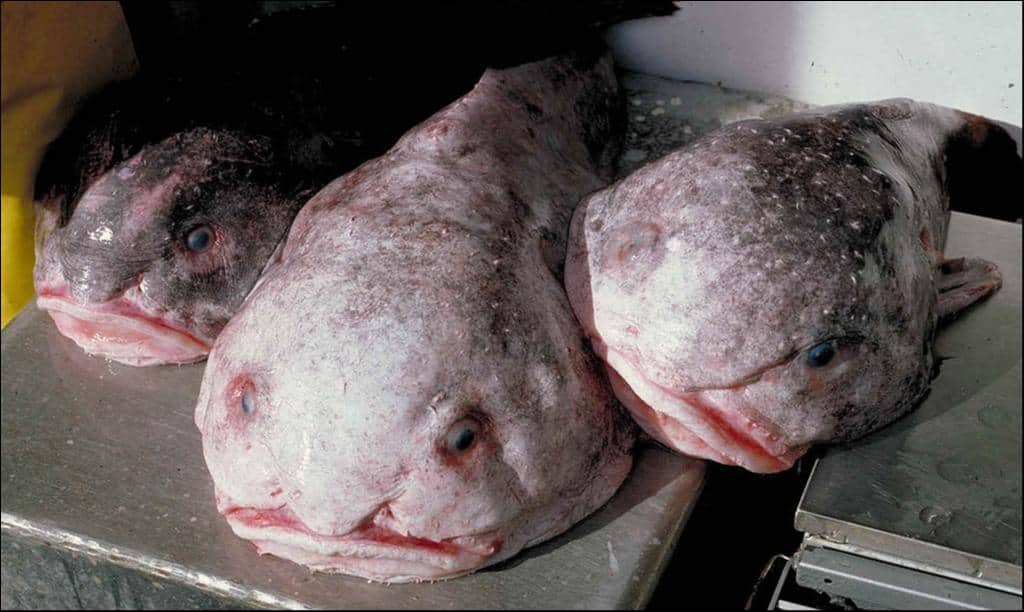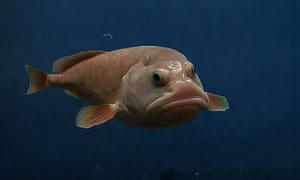Living life as a blob isn’t easy!
Blobfish don’t have any natural predators. But they still have to survive in their deep-sea environment. These well-evolved blobs may be able to sense pressure changes and adjust their form to remain comfortable. Isn’t that amazing?
There’s no doubt about it; blobfish are among nature’s most resilient creatures. It’s not just their unique ability to survive these conditions that make them so remarkable; it’s also the fact that they still manage to look so cute!
Read on to learn about the blobfish habitat and what it’s like to live as a blob.
Life as a Blob: Blobfish Habitat

The blobfish’s natural habitat is in the mesopelagic ocean zone off the Coast of Australia and New Zealand.
©NOAA/MBARI / public domain – License
The blobfish’s natural habitat is in the mesopelagic ocean zone off the Coast of Australia and New Zealand. In the dark deep waters of the ocean, there’s little oxygen or sunlight. The water pressure is intense, and the temperatures are very cold. It’s not an environment many animals can survive in.
Unique Marine Animals off Australias Coast
What other marine animals live in the same waters as a blobfish? While they won’t be as deep down, sharks swim off the coasts of Australia too. Other unique marine animals found off the coast of Australia include seals, penguins, jellyfish, and dugongs.
Fun fact; the dugongs are the ocean’s only mammal species that are strictly herbivorous. Blobfish are omnivores, but we’ll dive into that later in the article. For now, let’s look at how deep these pink blobby fish swim!
How Deep Do Blobfish Live?

Blobfish live 2,000 to 4,000 feet below the ocean’s surface.
©World-Wide-Photography/Shutterstock.com
Blobfish live 2,000 to 4,000 feet below the ocean’s surface. This deep and dark environment has scarce food sources for blobfish to feed on. But it does provide protection from predators.
The pressure at this ocean depth is extreme – it’s much heavier than the pressure on land. This is why the blobfish can only survive in these depths and not at sea level.
It’s hard to see a blobfish in the wild. Most specimens are already dead when humans encounter them. This is because the pressure levels at sea level are too high for a blobfish to survive. To catch a glimpse of this unique creature, you’d have to venture deep into the ocean and explore the depths of its habitat.
Blobfish Behavior
These pink blobs are a mystery! Little is known about their behavior in the wild, as it’s challenging to observe them due to their extremely deep habitat.
Experts believe blobfish prefer to remain at rest, as they have low metabolisms. They likely don’t expend much energy scouring the ocean floor for food and can even go days without eating. Blobfish skin is slightly less dense than water, which helps prevent them from vomiting up the contents of their stomachs!
Blobfish Diet and Hunting Style
What do blobfish eat? As omnivores, these pink blobs eat a little bit of everything. The blobfish diet consists mainly of small animals, like crabs and worms. They wait patiently for their prey to pass by before snatching it up with one of their long tentacles. One of their favorite snacks is copepods.
Copepods are tiny aquatic crustaceans that inhabit various salinities, from freshwater to hypersaline conditions. They can be found virtually everywhere there is water and provide an easily accessible food source for blobfish. Blobfish can find them by rooting around on the seabed and snatching them up with their enormous mouths.
Blobfish Lifespan and Anatomy

The lifespan of blobfish is 100 years or longer.
©Alan Riverstone McCulloch (1885-1925) / public domain – License
The lifespan of blobfish is 100 years or longer. Under the right conditions, they can live to be over 130 years! Adults grow to be around a foot long.
The blobfish has a fascinating story behind its evolution. There’s more to this bizarre-looking species than meets the eye. Its jelly-like skin is perfectly adapted for life in the ocean’s depths, and its relaxed lifestyle allows it to conserve energy.
Their bodies are made up of soft bones and barely any muscles, and they lack a swim bladder – an internal gas-filled organ that helps most fish stay afloat in the water. Despite this, blobfish float just above the bottom thanks to their jelly-like consistency, which is close in density to the surrounding water.
Who Are the Blobfish’s Neighbors?
The blobfish has a few neighbors! Lanternfish, anglerfish, and other deep-sea species coexist with blobfish in the ocean depths. The deep water zone is home to some of the most fascinating creatures on Earth and provides a unique opportunity to explore life in extreme environments. The giant squid is another one of the blobfish’s famous neighbors.
Overall, blobfish don’t have a lot of company in their natural habitat. A lot of marine species are unable to survive in extreme deep-sea environments. The blobfish’s unique adaptations have helped them to thrive in this environment, surviving off a diet of small animals and slowly floating near the seafloor.
Blobfish are helpful ocean residents. They help clean things up by eating marine carcasses that float down to the ground. This makes the blobfish an essential part of the marine ecosystem and a fascinating creature that has adapted to life in the abyss.
Can Blobfish Outswim Humans?
A blobfish can swim deeper than you could ever hope to! Your lungs would collapse if you tried to swim alongside a blobfish. The water is just too deep!
The deeper a blobfish goes, the more pressure it experiences from the surrounding water. At around 3,280 feet in depth, the pressure is approximately a hundred times heavier than on land. This type of pressure is unsustainable for human lungs.
How Blobfish Withstand Extreme Pressure
How do blobfish withstand the extreme pressure in their habitat? As mentioned, blobfish don’t have a swim bladder and rely instead on their jelly-like consistency to float. This soft substance helps them withstand heavy ocean pressure without imploding. Blobfish also possess slow metabolisms, allowing them to conserve energy and survive in low-oxygen environments.
Why Do Blobfish Look Different Underwater?

Blobfish rely on water pressure to shape their bodies.
©lacking author information / public domain – License
Blobfish aren’t flabby! They appear to be gigantic blobs when we see them out of their natural environment. But blobfish look much different underwater.
Lacking thick bones and strong muscles, blobfish rely on water pressure to shape their bodies. In their natural environment, blobfish resemble giant tadpoles. These pink fish have feathery pectoral fins, large heads, big jaws, and tapered tails.
Without the support of the water pressure, a blobfish collapses, and its features become unrecognizable. This is why it looks much more like a gelatinous blob when it’s out of the ocean.
Meet Mr. Blobby
Have you heard of Mr. Blobby? He’s the best-known blobfish specimen and a real celebrity in the marine world. Mr. Blobby was discovered by a research vessel, NORFANZ, in 2003 and is preserved at the Australian Museum.
Named after a children’s T.V. show character, “Mr. Blobby” is a special specimen. This rare individual resembles an inflatable character balloon that has lost most of its helium. He was voted the ugliest animal on Earth in a mascot contest held by the comedy/conservation troupe, the Ugly Animal Preservation Society, in 2013.
Final Thoughts on Blobfish Habitat
Blobfish are an essential part of the deep-sea ecosystem and offer a unique look into life in extreme environments. They’ve adapted to thrive in this environment, surviving off a diet of small animals and slowly floating near the ocean floor.
Gelatinous pink blobfish is one example of how animals can adapt to and survive in extreme conditions. Their fascinating physiology is key to their survival, allowing them to bob along the ocean for food and protection from predators.
Despite our lack of knowledge about these deep-sea jellies, new information is coming to light daily. We know that blobfish are usually inactive and can go days without eating to conserve energy. They just lay on the ocean floor and waited, bobbing with the current. Sometimes, it’s best to go with the flow!
Up Next:
- Discover The World’s 5 Largest Squid
- The Best Tank Decorations for Your Aquarium 2022
- Blobfish Conservation Status: Are Blobfish Endangered?
The photo featured at the top of this post is © World-Wide-Photography/Shutterstock.com
Sources
- Penn State, Available here: https://sites.psu.edu/sinkorswim/tag/blobfish/
- Island Bay Marine Education, Available here: https://octopus.org.nz/content/blobfish-facts
- American Association for Advancement of Science, Available here: https://www.aaas.org/news/weird-wonderful-creatures-blobfish
Thank you for reading! Have some feedback for us? Contact the AZ Animals editorial team.




